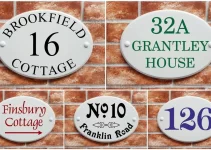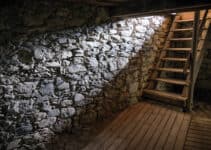Living in an old house comes with many quirks, some of which can be very worrying on the surface. A great example of this is the cracks you might have noticed in the walls of your old house.
After noticing them, you might be asking yourself, why do old houses crack? And, more importantly, when should you worry about these cracks? Old houses crack due to the natural settling of the foundation over time and the expansion and contraction of building materials in response to changes in temperature and moisture.
There are many external factors like soil movement, tree roots, and environmental conditions can also contribute to structural changes and cracks.
Well, this article will tell you everything you need to know about why old houses crack, what to do, and when you should be worried about them.
Is it Normal for an Old House to Have Cracks?
It’s fairly normal for an old house to have cracks in the walls. There are numerous reasons why this might have happened, some of which are more serious than others. Arguably, it’s more worrying for a new house to have cracks in the walls, as this is a sign of a recent issue.
As for old houses, when they’ve been standing for a few decades or more, it’d be surprising if no cracks had formed in the walls. To understand why, let’s look at the reasons why old houses crack.
Cracks in Walls Old House UK
There are so many reasons why an old house has cracks in the walls. We’ll cover some of the more common ones here, including ones that should concern you, which we’ll explain in more detail later.
1. Settling
Old houses settle over time for several reasons. The first is the materials used, such as lime mortar, which don’t set hard in the same way as modern building materials. Another is that old houses were built on different foundations, which could themselves move or settle.
Cracks that are the same size the whole way up generally aren’t a cause for concern. But if you notice a crack that’s wider at the top than the bottom, you should think about getting it investigated.
2. Plaster Shrinkage
Another common cause of cracks is plaster shrinking. This typically has nothing to do with the wall underneath, so is never really a cause for concern. Shrinkage happens as moisture escapes the plaster, so this should only really happen as the plaster is drying.
3. Subsidence
Subsidence is often a danger word when it comes to home ownership, and for good reason. It’s caused by the ground under the foundations giving way, causing walls to slip. You can usually spot subsidence by its characteristic V-shaped cracks in walls.
There are lots of causes of subsidence, such as houses built on soft ground, tree roots, nearby groundwork, and more. It can be a difficult problem to solve, but it’s a rarer issue than the others on this list.
4. Moisture and Damp
Damp can cause cracks, or can be caused by cracks. For example, a crack on an outside wall can let moisture in, causing damp and mold inside your home. But damp can lead to structural weakness in certain building materials, causing cracks in walls.
Either way, damp is a problem you’ll want to get sorted ASAP. Whether for your home’s health or your own, it’s not a great idea to leave damp lingering for too long.
5. Tree Roots and Plants
Tree roots can be very aggressive and can easily push through building materials if there’s a small crack to begin with. Large tree species can have extensive root networks, which can cause subsidence or other structural issues. If you have a large tree planted near your home, this could be a cause of wall cracks.
Similarly, climbing plants like ivy can cause cracks in walls. Ivy generally uses suckers to hold onto walls, but its roots can cause issues lower down. The same is true for other popular climbers like wisteria.

Is it Normal for 100 Year Old House to Have Cracks?
Again, it’s fairly normal for 100-year-old houses to have cracks in the wall or high ceiling. It’s worth noting, though, that these may not be caused by structural issues. A more common cause is the degradation of building materials, especially things like plaster.
There are some tell-tale signs of whether a crack is structural or superficial. The first is shape: stepped, V-shaped or horizontal cracks can often signal building problems. But diagonal or random-shaped cracks will likely be plaster-related.
Also, try and assess the depth of the crack. If it looks pretty shallow, it’s probably just a plaster crack. You’ll know when a crack is deep because it’ll be pretty obvious.
However, if you’re concerned, contact a specialist for confirmation either way. After all, you don’t want to ignore a problem only for it to get worse!
Do Cracks Mean Foundation Problems?
Cracks don’t always mean foundation problems. In fact, it’s one of the less common reasons for walls cracking. What’s more, it’s fairly easy to tell whether a crack is foundation related because it’ll show characteristic signs, which are discussed below.
When Should I Worry about Cracks in My House?
So, when should you worry about cracks in walls? Well, there are some initial points to consider, which include:
Size and Age
These two points are somewhat related. For example, if you notice a new crack, it could be a sign that something is happening. However, if you can see a crack and it looks like it’s been repaired, this usually isn’t something to worry about.
If the crack is more than 15 mm wide, you should get someone to look at it. Aside from the cause, cracks of this size can let in a lot of moisture, leading to damp problems. Cracks that are 5 mm or less can usually be treated with DIY, provided you keep an eye on them.
Shape and Direction
Next, look at the shape and direction of the crack. If it starts at the bottom of the wall, it could be a sign of a foundation problem, or it could simply be the building settling. Monitor it for changes in size.
Stepped cracks are ones that, unsurprisingly, look like steps going up a wall. This is caused by the mortar between bricks cracking, as it’s weaker than the surrounding brick. It can be caused by structural movement and should be looked at quickly.
Horizontal cracks can be caused by the building shifting or walls bulging, which can be common in old homes. In fact, it’s why a lot of old buildings have iron crosses on the outside – these are from support bars pushed through the building. Again, if it looks fairly new, get a professional to take a look.
Which House Cracks are Serious?
The most serious cracks in a house are stepped, V-shaped and horizontal cracks. These often signal structural problems and should be investigated quickly. Vertical cracks are often caused by the building settling, so shouldn’t be as much of a concern.
Similarly, look at how big the crack is. Anything over 15 mm should be checked ASAP, as these are considerable issues. Smaller ones can be checked by a professional, but little hairline cracks can be fixed with DIY.
If you’re unsure about the age of a crack and whether it’s live, you can monitor it before calling someone out. A good way to do this is to mark the end point with a pencil mark, including the date. Check it every few weeks to see if the crack is growing. It can help to write the width with the date so you can monitor that too.
However, be aware that it can take up to a year to get the information you need. Cracks will often grow with the changing seasons, especially ones related to ground problems. As the ground gets wet and dries out throughout the year, it can lead to foundations sinking. This’ll obviously take a few seasons to notice.
What To Do About Cracks in Your Walls
How you deal with the problem will depend on whether you own the building. If you’re a renter, get in touch with your landlord, as it’s their responsibility to have the cracks checked. If you rent, don’t bother monitoring the crack for changes, get your landlord to inspect it immediately.
However, if you’re a homeowner, you might be willing to take the longer approach. Your home insurance should have subsidence cover on it, but the excess can often be higher than your standard one. Look at your policy to see what coverage you have.
The first step should be to have a professional look at the problem. Use their advice to plan your next steps, including deciding whether it’s something you can (and should) claim on your insurance. Subsidence claims have to be declared for future policies, but this is something you’ll definitely want to claim for.
Final Thoughts
The bottom line is that it’s fairly standard for old houses to have cracks in the walls. Whether they’re a problem, and what you do about it, depends on the size, direction, shape, and more.
If you’re unsure how to handle the problem, get a builder or other structural professional to look at the crack. From there, you can at least make an informed decision about how to repair it.



